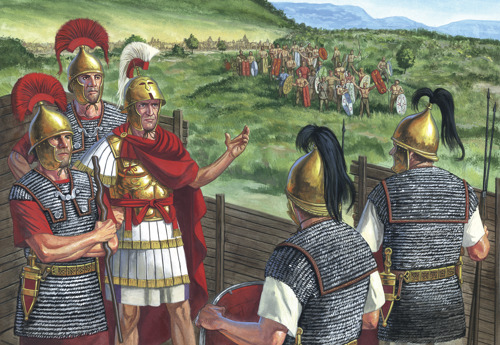
Today we're showing three pieces of artwork from our August 2023 series books! Let us know in the comments which books you'd like to see featured in our September 2023 Artwork Reveal!
The Cimbrian War 113–101 BC: The Rise of Caius Marius
By Nic Fields
Illustrated by Johnny Shumate

THE TEUTONES TAUNT THE ROMANS: MARIUS’ CAMP AT AQUAE SEXTIAE, 102 BC
Marius’ camp between the Rhodanus and Isara rivers, on the other hand, was of a more permanent nature, as witnessed by a palisaded rampart here. The turf-revetted rampart, with its more sturdy palisade of planks or hurdles, was studded with timber observation towers and pierced by four gateways, and fronted a double-ditch system. Sharpened forked branches (cervi) were firmly embedded in the top of the earthwork so they projected horizontally to prevent any attempt to scale it. Behind these substantial defences the Romans idle, or so it seems to the Teutones beyond. Fierce, proud, and fearless, a group of Teutones try to tempt the Romans out by whistles, boos, catcalls, and jeers. Lucius Cornelius Sulla, one of Marius’ legati, provides reassurances to his legionaries, accompanied by two centurions, one of whom holds a vine staff.
In the background, heading south-eastwards and away from the Roman camp, four-wheeled wagons and two-wheeled carts drawn by draft animals carry the kinfolk and chattels of the fighting men. In their wake trudge the communal livestock tended by the adolescent Teutones. It is an engorged, sluggish caravan strung out for miles as it traverses the waning afternoon – people, oxen, cattle, mules, wagons, and carts.
Artwork requested by Paul Williams.
The Blitz 1940–41: The Luftwaffe's biggest strategic bombing campaign
By Julian Hale
Illustrated by Mads Bangsø

John Cunningham’s most successful night
In the early hours of 16 April 1941, Heinkel He 111P-2, G1+ES of 8./KG 55, was returning homewards. The crew were unaware that they were being tracked by a Beaufighter flown by Sqn Ldr John Cunningham and Sgt ‘Jimmy’ Rawnsley. Cunningham had already spotted anti-aircraft fire near Marlborough, before Rawnsley’s AI set detected the Heinkel as it passed in front of the Beaufighter. Cunningham turned after the Heinkel and, after identifying the aircraft against the night sky, pulled up the nose of the Beaufighter and opened fire from a range of 80yds. The attack caught the Heinkel’s crew by complete surprise. Cunningham reported a ‘big flash’ in the fuselage, after which the Heinkel dived away to the left. Fire broke out inside the aircraft. The pilot, Oberleutnant Günther von Siedlitz, jettisoned the bombs, then ordered the crew to abandon the stricken aircraft. Two of the crew, Unteroffiziers H. Sauer and H. Rosenberg, escaped, although one, already wounded, broke his leg on landing. The aircraft’s Beobachter, Feldwebel F. Hümmer, was killed when his parachute was apparently torn off when it struck a balloon cable. Siedlitz’s parachute failed to open properly and he too was killed. The wreckage of the Heinkel crashed into an abandoned house in Padwell Road, Portswood, where it burned itself out. This was Cunningham’s second of three claims on 15/16 April.
Artwork requested by Adam Cooper.
Operation Black Buck 1982: The Vulcans' extraordinary Falklands War raids
By Andrew Bird
Illustrated by Adam Tooby

Vulcan B.2/Black Buck 5 targets a Westinghouse AN/TPS-43 3D radar, 31 May 1982
On 31 May 1982, Avro Vulcan XM597 was deployed carrying a pair of AGM-45 Shrike anti-radiation missiles with a DASH-10 ECM. Squadron Leader, Neil McDougall, piloting XM597, kept off whilst a Sea Harriers attack was staged on Port Stanley airport designed to coincide with the attack from the Vulcan to force the defenders to turn on their radar. Vulcan XM597 twisted and turned before the crew got a lock-on and were able to launch the missiles. At 0845Z, two Shrikes were launched. One of them fell about 8 to 10m from the antenna, but most of its shrapnel was absorbed by the 601 GADA truck positioned between the impact area and the antenna. This illustration shows Vulcan XM597 flying through cloud cover with two of its launched Shrike missiles hurtling towards their target.

Comments
You must be logged in to comment on this post. Click here to log in.
Submit your comment